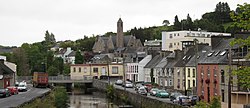Donegal
| Donegal Irish: Dún na nGall | |
| County Donegal | |
|---|---|
 Donegal Town | |
| Location | |
| Grid reference: | G924789 |
| Location: | 54°39’-0"N, 8°7’1"W |
| Data | |
| Population: | 2,339 (2006) |
| Post town: | Donegal |
| Postcode: | F94 |
| Dialling code: | 074 |
| Local Government | |
| Dáil constituency: |
Donegal South West |
Donegal, usually referred to as Donegal Town is a town in County Donegal. Its name, which was historically written as Dunnagall or Dunagall, is from Irish language, meaning "stronghold of the foreigners" (namely the Vikings).
Donegal gave its name to County Donegal, although Lifford is the county town. Donegal town sits at the mouth of the River Eske and Donegal Bay, which is overshadowed by the Bluestack Mountains. The centre of the town, known locally as the Diamond, is a hub for music, poetic and cultural gatherings in the area.
The town is bypassed by the N15 and N56 roads.
History
There is evidence for settlements around the town dating back to prehistoric times including the remains of round forts and other earth works.
It is generally accepted by historians that St Patrick was captured by raiders from the Clans governed by Niall of the Nine Hostages and that this region is that to which St Patrick returned; being familiar with the people, language, customs and lands. The first Clan to convert to Christianity as the result of St Patrick's efforts was the Clan Connaill (also known at one time as Clan Dalaigh) o Tyrconnell. Connaill was a son of Niall of the Nine Hostages. As a result, on their acceptance of Christianity, St Patrick bless the clan members and the sign of the Cross appeared on the chieftains shield and this became not only the coat of arms for the clan but also for County Donegal.
There is a record of an early fortress being destroyed by Muirchertach Mac Lochlainn, High King of Ireland in 1159. This Viking settlement is possibly the origin of the town's name though ancient traditions have the O'Donnells descended from the line of King Miles of Spain, the mythical progenitor of the Milesians who in Irish myth invaded and settled Ireland.
Donegal Town itself is famous for being the former centre of government of the dynasty of O'Donnell of Tyrconnell, who played a pivotal role in Irish history, and whose original homeland lay further to the north in the area of Kilmacrenan. From the 15th to the 17th century, they were an important part of the opposition to the colonisation of Ireland from Great Britain. The town itself contains Donegal Castle, on the banks of the River Eske and the remains of a Franciscan abbey which dates back to the 15th century on the Southern shore of the Bay. The Annals of the Four Masters was written in the abbey in the early 17th century.
The story of Aodh Rua Ó Domhnaill (Red Hugh O'Donnell), Lord of Tyrconnell, was the inspiration behind many books and films, not least, Disney's The Fighting Prince of Donegal (1966).
After the Flight of the Earls in 1607 the castle and its lands were given to an English captain, Basil Brooke, as part of the Plantation of Ulster. Brooke carried out major reconstruction work and added a wing to the castle in the Jacobean style. The current plan of the town was also laid out including an attractive town square or Diamond. From the late 17th until the early 20th centuries, Donegal Town formed part of the vast estates of the Gore family (from 1762 Earls of Arran) and it while in their ownership that the town took on its present appearance.
Industry and tourism
There are many sandy beaches in the area of Donegal, such as Murvagh beach, and some boasting good surfing conditions, such as Rossnowlagh. Donegal is also used as a base for hill-walking in the nearby Bluestack Mountains. Despite the town's many hotels catering for visitors, it suffers from a lack of social amenities for its local population. Many have to travel to nearby towns such as Letterkenny for facilities like public swimming pools, cinemas and large shopping centres.[1]
Further reading
Aldwell, B. 2003. A survey of local resident butterflies in County Donegal. Bull. Ir. biogeog. Soc. No. 27. 202 - 226.

